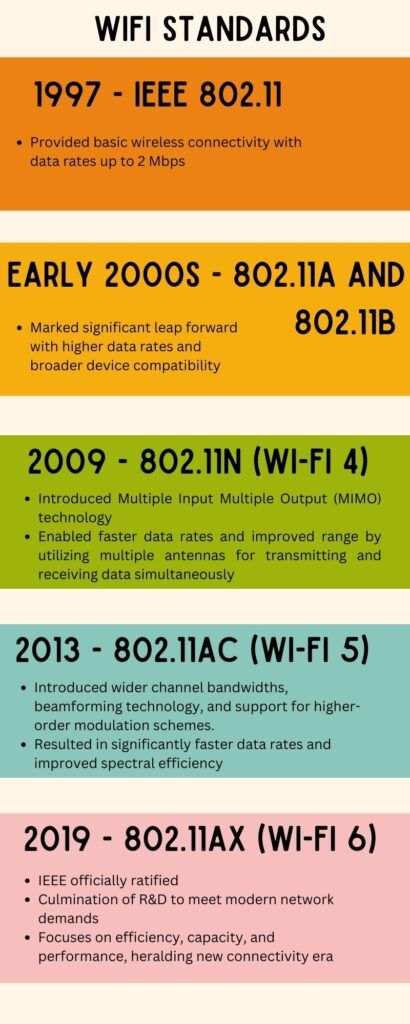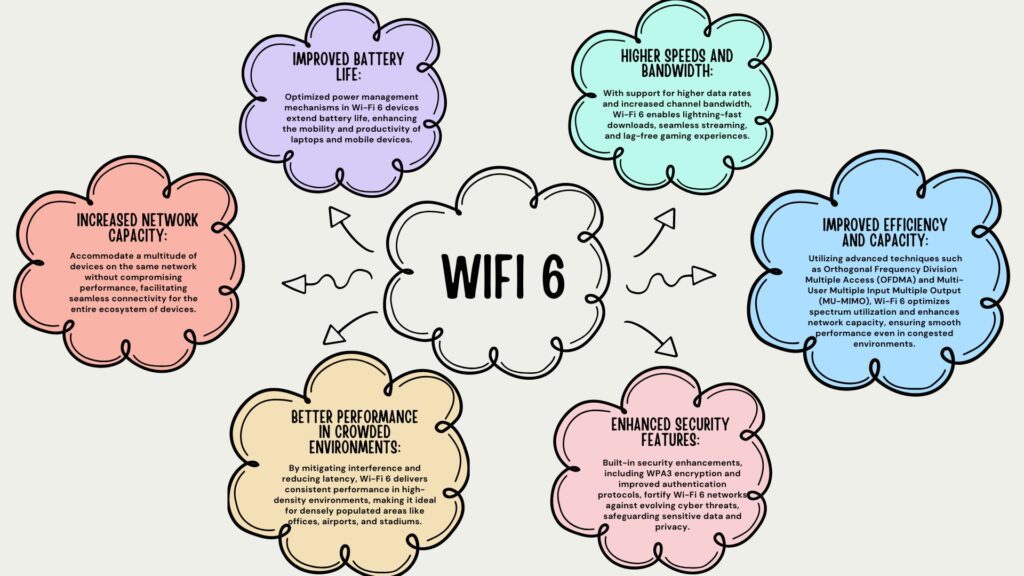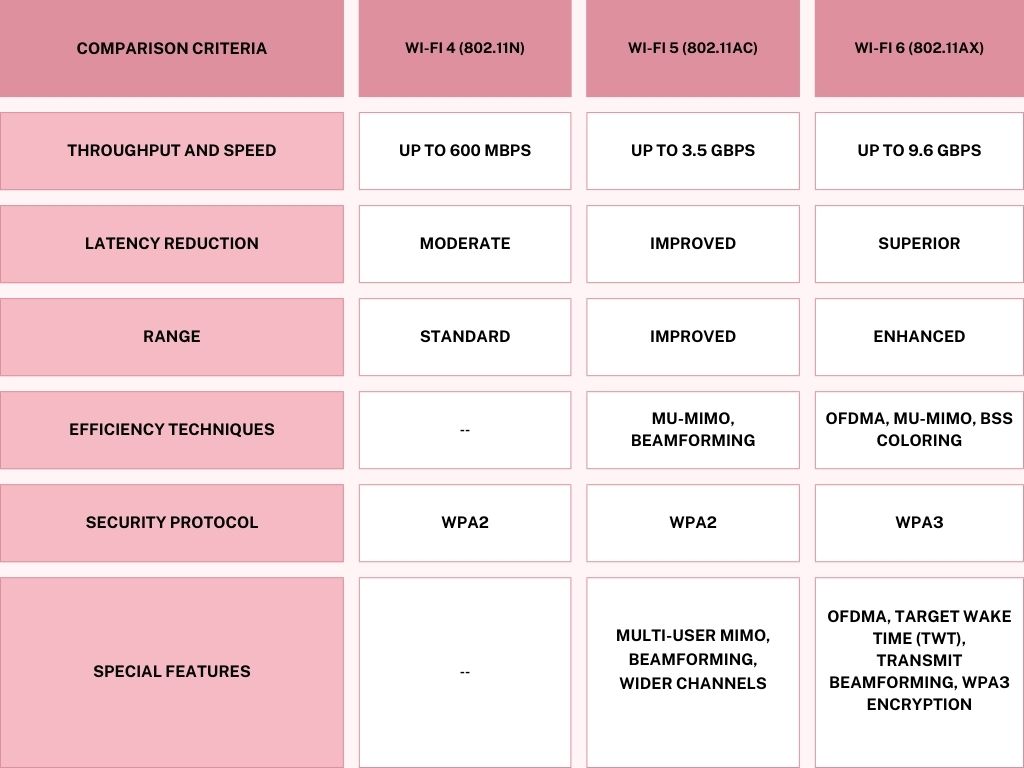- Made In INDIA

The evolution of Wi-Fi standards has been a remarkable journey, with each new generation bringing significant improvements in speed, capacity, and efficiency. As we approach the era of Wi-Fi 6, it is essential to understand its impact on today’s digital landscape, especially for desktop and laptop users. With the increasing reliance on wireless connectivity for a wide range of applications, Wi-Fi 6 is poised to revolutionize the way we connect and communicate, particularly in the domain of desktop and laptop computing.
The evolution of Wi-Fi standards traces back to the early days of wireless communication when the IEEE 802.11 working group laid the foundation for what would become a revolutionary technology. Beginning with the release of the original 802.11 standard in 1997, which provided basic wireless connectivity with data rates up to 2 Mbps, the journey towards Wi-Fi 6 has been marked by a series of significant milestones and advancements.

As the demand for wireless connectivity surged, subsequent iterations of the standard sought to address key limitations and enhance performance. The introduction of 802.11a and 802.11b in the early 2000s marked a significant leap forward, offering higher data rates and compatibility with a broader range of devices. 802.11g followed suit, combining the best aspects of its predecessors to deliver faster speeds and improved reliability.
However, it was the advent of 802.11n, commonly referred to as Wi-Fi 4, that truly revolutionized the wireless landscape. Introduced in 2009, Wi-Fi 4 introduced Multiple Input Multiple Output (MIMO) technology, enabling faster data rates and improved range by utilizing multiple antennas for transmitting and receiving data simultaneously. This breakthrough paved the way for widespread adoption of Wi-Fi in both consumer and enterprise environments.
Building upon the foundation laid by Wi-Fi 4, the subsequent release of 802.11ac, or Wi-Fi 5, in 2013, represented another quantum leap in performance. Wi-Fi 5 introduced advancements such as wider channel bandwidths, beamforming technology, and support for higher-order modulation schemes, resulting in significantly faster data rates and improved spectral efficiency.
Amidst this backdrop of innovation and progress, the stage was set for the arrival of Wi-Fi 6, or 802.11ax. Officially ratified by the IEEE in 2019, Wi-Fi 6 represents the culmination of years of research and development aimed at addressing the ever-growing demands of modern wireless networks. With its focus on enhancing efficiency, capacity, and performance, Wi-Fi 6 heralds a new era of connectivity, poised to redefine the way we experience wireless communication.
In summary, the evolution of Wi-Fi standards has been characterized by a relentless pursuit of excellence, driven by the imperative to meet the evolving needs of users and applications. From humble beginnings to the cutting-edge technology of Wi-Fi 6, each iteration has brought us closer to the vision of ubiquitous, high-speed wireless connectivity. As we embark on the next chapter of this journey, the possibilities for innovation and advancement in wireless communication are truly limitless.
Wi-Fi 6 heralds a new era of connectivity, marked by a plethora of innovative features and enhancements. At its core, Wi-Fi 6 delivers:
With support for higher data rates and increased channel bandwidth, Wi-Fi 6 enables lightning-fast downloads, seamless streaming, and lag-free gaming experiences.
Utilizing advanced techniques such as Orthogonal Frequency Division Multiple Access (OFDMA) and Multi-User Multiple Input Multiple Output (MU-MIMO), Wi-Fi 6 optimizes spectrum utilization and enhances network capacity, ensuring smooth performance even in congested environments.
Built-in security enhancements, including WPA3 encryption and improved authentication protocols, fortify Wi-Fi 6 networks against evolving cyber threats, safeguarding sensitive data and privacy.
By mitigating interference and reducing latency, Wi-Fi 6 delivers consistent performance in high-density environments, making it ideal for densely populated areas like offices, airports, and stadiums.

Experience blazing-fast internet speeds for seamless content consumption, file transfers, and multimedia streaming.
Enjoy stable and consistent connectivity, even in challenging wireless environments, ensuring uninterrupted productivity and communication.
Accommodate a multitude of devices on the same network without compromising performance, facilitating seamless connectivity for the entire ecosystem of devices.
Optimized power management mechanisms in Wi-Fi 6 devices extend battery life, enhancing the mobility and productivity of laptops and mobile devices.
From video conferencing and online gaming to 4K video streaming, Wi-Fi 6 empowers users to indulge in bandwidth-intensive activities without compromise, thanks to its superior throughput and efficiency.
The evolution of Wi-Fi standards has been a journey marked by continuous innovation and advancement, each iteration building upon the achievements of its predecessors. With the introduction of Wi-Fi 6 (802.11ax), the wireless landscape has once again undergone a significant transformation, promising unparalleled speed, efficiency, and reliability. We will see comparisons of Wi-Fi 6 with its predecessors, Wi-Fi 5 (802.11ac) and Wi-Fi 4 (802.11n), across key parameters to understand the magnitude of improvements and benefits brought forth by this groundbreaking technology.

One of the most notable advancements in Wi-Fi 6 compared to previous standards is its remarkable increase in throughput and speed. While Wi-Fi 4 and Wi-Fi 5 offered impressive data rates, with Wi-Fi 4 reaching up to 600 Mbps and Wi-Fi 5 up to 3.5 Gbps, Wi-Fi 6 takes it to a whole new level. With theoretical maximum speeds of up to 9.6 Gbps, Wi-Fi 6 boasts significantly higher throughput, enabling lightning-fast downloads, seamless streaming, and lag-free gaming experiences.
Reducing latency and extending range have been focal points of Wi-Fi development, and Wi-Fi 6 delivers substantial improvements in these areas. Through advanced technologies like Orthogonal Frequency Division Multiple Access (OFDMA) and Target Wake Time (TWT), Wi-Fi 6 significantly reduces latency and enhances range performance compared to its predecessors. This ensures smoother and more responsive connectivity, even in challenging wireless environments.
Wi-Fi 6 introduces revolutionary techniques to optimize spectrum utilization and enhance network capacity, addressing the growing demands of modern wireless networks. Features like OFDMA, Multi-User Multiple Input Multiple Output (MU-MIMO), and Basic Service Set (BSS) Coloring allow Wi-Fi 6 networks to support a larger number of devices simultaneously, without compromising performance. This translates into a more efficient and robust wireless experience, particularly in high-density environments like offices, airports, and stadiums.
Security remains a top priority in wireless communication, and Wi-Fi 6 introduces several enhancements to fortify network defenses against evolving cyber threats. With the introduction of WPA3 encryption and improved authentication protocols, Wi-Fi 6 networks offer superior protection for sensitive data and privacy compared to its predecessors. This ensures peace of mind for users, knowing that their wireless connections are safeguarded against unauthorized access and malicious attacks.
Wi-Fi 6 (802.11ax) is being implemented and utilized in practical settings. This section explores the various scenarios where Wi-Fi 6 is being deployed and the specific applications and benefits it offers in those environments.
Overall, Wi-Fi 6 deployment in real-world scenarios is driven by the need for faster speeds, better coverage, increased capacity, and improved reliability across a diverse range of environments and applications. As the adoption of Wi-Fi 6 continues to grow, it is expected to redefine the way we connect and interact with wireless networks, ushering in a new era of connectivity.

As we look beyond Wi-Fi 6, the future of wireless technology is exciting. Here are some potential advancements and emerging technologies in the field of wireless connectivity:
The next iteration of Wi-Fi, known as Wi-Fi 7 or 802.11be, is already on the horizon. It’s expected to offer even higher data rates (potentially up to 30 Gbps), lower latency, and improved efficiency. Wi-Fi 7 will likely continue to enhance the features introduced in Wi-Fi 6, such as OFDMA and MU-MIMO, while introducing new technologies like coordinated multi-user MIMO.
The integration of Wi-Fi 6 with 5G networks is another promising development. 5G is the next generation of cellular technology, offering high speeds, low latency, and the ability to connect a massive number of devices simultaneously. The convergence of Wi-Fi 6 and 5G could provide seamless, ultra-fast connectivity both indoors and outdoors.
Emerging wireless communication protocols like WiGig (802.11ad and 802.11ay) are designed for short-range, high-speed data transfers, potentially up to 20 Gbps. These could complement Wi-Fi by providing high-speed connectivity for specific applications, such as VR/AR, uncompressed video streaming, and quick file transfers.
Artificial Intelligence (AI) and Machine Learning (ML) are set to play a significant role in the future of wireless connectivity. They can be used to optimize network performance, predict and mitigate issues, and provide personalized experiences. For example, AI could be used to intelligently manage network traffic, ensuring each device gets the bandwidth it needs for optimal performance.
As wireless connectivity becomes increasingly integral to our daily lives, security will continue to be a critical concern. Future Wi-Fi standards will likely introduce even more robust security features to protect against evolving threats. This could include more advanced encryption methods, improved user authentication, and features designed to maintain privacy.
The future of wireless connectivity is bright, with many exciting advancements on the horizon. As we move towards a more connected world, technologies like Wi-Fi 6 and beyond will play a crucial role in enabling seamless, secure, and high-speed connections.
As we conclude our exploration into Next-Gen Connectivity with a focus on Wi-Fi 6 and beyond, it becomes evident that we stand at the threshold of a transformative era in wireless communication. The journey of Wi-Fi standards, from the inception of 802.11 to the groundbreaking advancements of Wi-Fi 6, reflects a relentless pursuit of excellence driven by the evolving needs of users and applications.
Wi-Fi 6 represents the pinnacle of this evolution, offering unprecedented speed, efficiency, and reliability to meet the demands of today’s digital landscape. With its higher speeds and bandwidth, improved efficiency and capacity, enhanced security features, and better performance in crowded environments, Wi-Fi 6 promises to revolutionize the way we connect and communicate.
The benefits of Wi-Fi 6 extend beyond mere connectivity. Faster downloads and uploads, more reliable connections, increased network capacity, improved battery life, and better performance for bandwidth-intensive applications pave the way for enhanced productivity, seamless collaboration, and enriched digital experiences.
Moreover, Wi-Fi 6 is not an endpoint but a stepping stone towards even greater advancements in wireless technology. The future outlook is promising, with emerging technologies like Wi-Fi 7, integration with 5G networks, advancements in wireless communication protocols, and the integration of AI and machine learning poised to further redefine the possibilities of wireless connectivity.
As a leading manufacturer of laptops and desktops, we recognize the importance of staying at the forefront of technological innovation. Through this white paper, our aim is not only to educate users about Wi-Fi 6 but also to inspire them to embrace the possibilities of Next-Gen Connectivity. By leveraging the power of Wi-Fi 6 and beyond, we empower users to unlock new levels of productivity, creativity, and connectivity in their digital journeys.
In conclusion, the future of wireless connectivity is bright, and we are excited to be a part of this journey towards a more connected and empowered world. Together, let us embrace the possibilities of Next-Gen Connectivity and pave the way for a future where seamless, high-speed wireless connectivity enriches every aspect of our lives.
©2024 Holoware® Computers Pvt. Ltd. | Privacy Policy | Terms & Condition
Roles & Responsibilities:
Preferred candidate profile:
Key Skills:
Location: Guindy & Porur
No of Openings: 3
Hindi Speaking is preferred
Fresher to 4 years experience in the relevant field is preferred.
Job description
We are seeking a motivated and detail-oriented Sales Coordinator to join our dynamic sales team. The Sales Coordinator will play a key role in supporting our sales representatives and ensuring smooth operations within the sales department. This position offers an exciting opportunity to contribute to the success of our sales initiatives and provide excellent customer service to our clients.
Role & responsibilities
Preferred candidate profile
Perks and benefits
Warranty Offers
Services with those steps are available
Solution With 24/7 Support
Get Started


In 1994, Mr.Thangavel started Origin Information Technology (in partnership with Mr. Loganathan) to provide quality computer hardware sales and service. In the year 2022, the company name was changed to “Tinkas Industries Private Limited” to encompass its diversified activities. Mr. Thangavel feels that he can give back to his nation the growth it needs in many ways like providing employment opportunities to many, and doing CSR activities, etc. His goal is to make Tinkas a leader at the National and Internaltional levels.
Holoware CEO abut Tinkas CEO
“The CEO of Tinkas (Mr.Thangavel) is undeniably one of the most practical and resourceful individuals I’ve encountered in Tamil Nadu. His profound understanding of the industry coupled with his diverse business ventures truly exemplifies his wealth of knowledge. Partnering with Tinkas has been a delight, and we eagerly anticipate further growth and collaboration.”
Mr. Ketan Patel is an indomitable entrepreneur revolutionizing the landscape of electronic consumer products worldwide through an unparalleled ‘experiential journey.’ Leading Creative Newtech since 1992, he steered its growth from a Mumbai market trader to a distributor and Brand Licensee. As an alumnus of IIM-Bangalore, Mr Patel leads Creative Newtech with a focus on innovation and strategic leadership. Under his three-decade leadership, Creative Newtech has become India’s market leader, expanding globally across Hong Kong, the Middle East, and the SAARC region.”
Holoware CEO abut Creative Newtech CEO
“The CEO of Creative (Mr.Ketan Patel) is a highly knowledgeable leader, renowned for his expertise in distributorship. His intuitive knack for product selection and sales strategies, both in India and abroad, is impressive. Creative thrives as a powerhouse, fueled by its diverse team and collective expertise. We eagerly look forward to a promising future and further success in our collaboration with Creative.”


Inmac Computers Private Limited is a trailblazing name in the realm of IT services and solutions. With a remarkable inception in 1992 by visionary entrepreneurs Girish Babu and Asha Girish Babu, our company has consistently remained at the forefront of technological innovation, setting new standards for excellence in the industry.
Holoware CEO abut Inmac CEO
“Inmac’s CEO (Mr.Girish Babu) is one of the most humble and generous individuals I’ve ever had the pleasure of meeting. His leadership has been instrumental in steering his team to success, not just in Maharashtra but across various regions in India. Their financial stability over the years speaks volumes about his capabilities. It’s truly a delight to collaborate with someone of his caliber. I look forward to continued partnership with Inmac.”